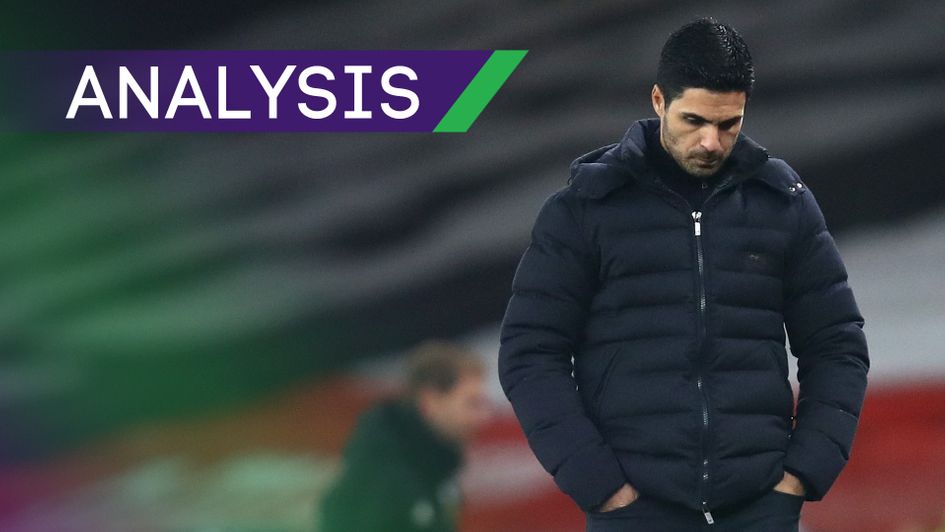Arsenal had bottomed out. They finished last season in their lowest position for a quarter of a century. Eighth, it seemed, was as low as they could go.
Until now? The age-old theory is that the league table takes shape after 10 games. After 10, Arsenal are 14th. The cliché is that the table lies, but it can be deceptive. One of the worrying elements for Arsenal, however, is that underlying numbers suggest that their position is broadly accurate so far.
Their attacking shortcomings have been the most visible problem. Arsenal’s tally of 10 goals is better only than the bottom three. In terms of goals per game, an average of 1.0 represents a dramatic downturn from 1.92 – and an eventual total of 73 – in 2018-19 and 1.47 last season; even that was their worst return since 1995-96. But while 15 teams had more attempts at goal last season, then Arsenal scored from 13 percent of their shots, the joint best in the league. Now that is down to 10 percent.
Nor do the numbers suggest they have been unlucky. They have had 92 shots; only Sheffield United, Burnley and Newcastle have had had fewer and the Clarets have a game in hand; they average 3.0 shots on target per game, better only than the same three sides. Their xG of 11.3 puts them 13th, above Southampton and Wolves, showing some of the chances they create are clear ones; equally, it is below Fulham’s 12.4.
Arsenal’s games have tended to be low-scoring, as an average of 2.2 goals per game this season suggests. Only five teams have conceded fewer than their 12 and they are the only side who have not let in a goal from any kind of set-piece, including penalties; the less flattering number is that only five have been breached more often in open play.
And, given Mikel Arteta’s excellence last season as a defensive strategist, perhaps the surprising element is that the rest of Arsenal’s defensive numbers are those of a bottom-half team. An expected goals against of 13.9 puts them 13th and gives them an xG difference of -2.6, which leaves them 15th.
They have made the 10th most saves and Arsenal have the sixth best post-shot expected goals minus goals allowed; in short, Bernd Leno, who has played all 10 league games, has saved more than he ‘should’ and Arsenal could have conceded more.
Why do Arsenal score so few goals?
Arsenal are only superficially good in possession; a pass completion rate of 83.3 percent is the fourth best, but it is more notable that 12 other teams have had a higher share of the ball than their 51.1. Most worryingly, they only rank 17th for shot-creating actions per 90 minutes. Only eight teams have more than their 81 passes into the penalty area, but that is resulting in too few opportunities; meanwhile, only Brighton and Leicester have created fewer shots from dead-ball situations.
Arteta has a counter-attacking blueprint, but too little of Arsenal’s possession has been in dangerous positions; they rank fourth for touches of the ball in their own third but only 13th in the opposition’s. Defensively, Arsenal have made the joint fewest tackles in the final third, which shows they are not pressing to regain the ball high up the pitch. That, in turn, is one explanation for the decline in their share of possession; Arsenal had 56.1 percent of the ball in 2018-19 and 58.5 percent in Arsene Wenger’s final season.
Possession is not a prerequisite of success but the numbers indicate Arsenal are not evolving as much as declining. They have only ‘won’ on expected goals in three of their 10 league games so far - against Fulham, Sheffield United and Manchester United – while both sides registered an xG of 0.74 when they faced Leicester. In contrast, they ended last season by recording a higher xG in six of their final nine games.
The early-season fixture list felt a mitigating factor. They have faced five of last season’s top seven and, substituting relegated Bournemouth and Norwich in for promoted Leeds and Fulham, they took 14 points from the equivalent games last season. In that context, a total of 12 does not represent a dramatic downturn.
But there is a broader trend. Only three of their 10 games have been decided by more than one goal; a 3-0 win over Fulham, a defeat by the same score to Aston Villa and the 3-1 loss at Liverpool, which was 2-1 until the 88th minute.
Games of fine margins have abounded in Arteta’s reign; 14 of his league matches last season were either drawn or decided by one goal, whether for or against. It underlines the importance of good goalkeeping – which Arsenal have had in both campaigns – and clinical finishing, which Arsenal benefited from last season rather more than this.
Those 21 close games in a year suggest Arsenal can generally be competitive against the best but struggle to see off the worst; it only gives them half of the ingredients of an elite side. As their matches have fewer goals and major chances than the average, they can boil down to a handful of clear openings. And it suggests that, if Arsenal are not a bottom-half team, they are at the least the definition of a mid-table side.
